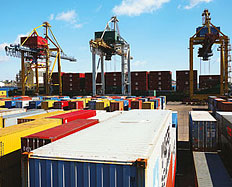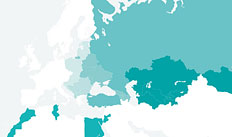Chapter 3
Box 3.4 Unilateral measures to safeguard national financial stability33
Over the last two years, various national regulators in home and host countries have taken measures to raise regulatory standards further (known as "gold plating") and to insulate national banking systems from the funding pressures and capital adequacy concerns experienced by a number of large European banking groups (known as "ring-fencing").
Survey evidence has underlined the risk of faster bank deleveraging in host countries than in home countries (see, for example, the IMF Global Financial Stability Report, April 2012). In response, host-country authorities have introduced measures to ring-fence local capital and liquidity in order to support local lending. Such measures can either take the form of micro-prudential regulation or macro-prudential tools. For instance, at the end of 2011 the Czech regulator announced measures to reduce exposures of banks to affiliated entities mainly impacting transactions between highly liquid subsidiaries and their foreign parent banks. Several other host countries announced similar measures at around this time (see Table 3.4.1). These examples are likely to underestimate the prevalence of actions of this type, as banks report that supervisors also used informal moral suasion, or explicit but unpublished bank-specific guidance through the Supervisory Review and Evaluation Process (SREP) under the Basel II prudential requirements, to restrict the free movement of capital between subsidiary and parent.
| Country | Home or host? | Type of measure | Description | Effective from |
|---|---|---|---|---|
| Bulgaria | Host | Capital | Required CAR 12% | Late 1990s |
| Serbia | Host | Capital | Required CAR 12% | 01/12/05 |
| Romania | Host | Capital | "Desired" CAR 10 to 11% | End-2008 |
| Hungary | Host | Lending conditions | Differentiated LTV and creditworthiness requirements for HUF and FX retail loans | 01/01/10 |
| Poland | Host | Lending conditions | Differentiated creditworthiness check, LTV and DTI requirements for PLN and FX retail loans | March 2006/August 2010 |
| Bulgaria | Host | Liquidity | Required liquidity buffers based on stress test results | 01/10/11 |
| Romania | Host | Lending conditions | Differentiated creditworthiness check, LTV and DTI requirements for RON and FX retail loans | 01/10/11 |
| Albania | Host | Legal form of operation | Conversion of foreign banks' branches into subsidiaries subject to local supervision | 01/11/11 |
| Poland | Host | Capital | Dividend restrictions (minimum CAR above 12%, Tier 1 ratio above 9%, internal supervision commission rating (BION) below 2.5, 50% cap on foreign currency-denominated retail lending, parent bank’s Tier 1 ratio above 9 %) | 01/12/11 |
| Serbia | Host | Capital | Capital conservation buffer of 2.5% effectively ruling out profit distribution below 14.5% CAR | End-2011 |
| Slovak Republic | Host | Capital | Minimum core Tier 1 ratio of 9% | |
| Slovak Republic | Host | Capital | Dividend restrictions (below core Tier 1 ratio 9.625% NBS recommends contributing all of their profits to build up capital buffers) | |
| Slovak Republic | Host | Liquidity | Maximum loan-to-stable-funding ratio of 110% | |
| Austria | Home | Liquidity | Net new lending to local stable funding ratio should remain below 110% as a guide | 01/01/12 |
| Hungary | Host/home | Liquidity | Deposit (similar to the LCR) and balance sheet (liquidity ratio) coverage ratios | 01/01/12 |
| Czech Republic | Host | Liquidity | Gross exposure limit to parents cut from 100% to 50% of Tier 1 and 2 capital | 01/04/12 |
| Hungary | Host/home | Liquidity | FX funding adequacy ratio (similar to the NSFR but for FX assets and liabilities) | 01/07/12 |
| Poland | Host | Capital | Higher risk weights on FX-denominated retail credit exposures | 01/07/12 |
| Austria34 | Home | Resolution | Group-wide recovery and resolution schemes | End-2012 |
| Austria34 | Home | Capital | CET1 4.5% | 01/01/13 |
| Austria34 | Home | Capital | Up to 3 percentage points surplus in CET1 for banking groups | 01/01/16 |
Note: abbreviations used: CAR Capital adequacy ratio (ratio of a bank's capital to its risk-weighted assets), CET1 Common equity Tier 1 (as defined in the Basel III framework)35
DTI Debt-to-income ratio (ratio of the debt instalment to the borrower's income), FX Foreign exchange, HUF Hungarian forint, LCR Liquidity coverage ratio (as defined in the Basel III framework),36 LTV Loan-to-value ratio (ratio of the outstanding loan amount to the value of the collateral), NBS National Bank of Slovakia, NSFR Net stable funding ratio (as defined in the Basel III framework)36, PLN Polish zloty, RON Romanian leu, Tier 1 and 2 Tier 1 and 2 capital (as defined in the Basel III framework).35
Although some host countries implemented stricter national regulations than required by EU legislation well before 2007 (for example, Bulgaria, Poland and Serbia), such measures became more frequent during the crisis. Table 3.4.1 reveals a bunching of both host and home-country measures around 2010-11. These were mostly reactions to the deteriorating capital coverage and funding situation of eurozone banks, or somewhat delayed responses to earlier credit booms in host countries (as in the case of regulations on lending standards in Hungary, Poland and Romania). Prudential requirements therefore appear to have been pro-cyclical, as they were tightened in an increasingly subdued lending environment. Some home authorities, as in Austria, introduced measures and deployed moral suasion aimed at gradually reducing excessive exposures to subsidiaries, and established programmes to support ailing lending to the public and non-financial private sectors at home.
Although the individual legitimacy of these measures cannot in most cases be contested, their uncoordinated application may have had the unintended consequence of fragmenting the EU financial market by increasing the cost of funding for banking groups and provoking further safeguard measures.
33 This box draws on D'Hulster (2011), Financial Stability Board (2012), and IMF (2012).
34 After long negotiations with different stakeholders, Austria introduced these measures as non-binding guidelines (which in Austria have a tradition as fairly effective supervisory tools). See: www.oenb.at/en/presse_pub/aussendungen/2012/2012q1/pa_aufsicht__nachhaltigkeitspaket_fuer_oesterreichs_banken__246091_page.jsp#tcm:16-246091.
35 See: www.bis.org/publ/bcbs189.pdf.
36 See: www.bis.org/publ/bcbs188.pdf.







